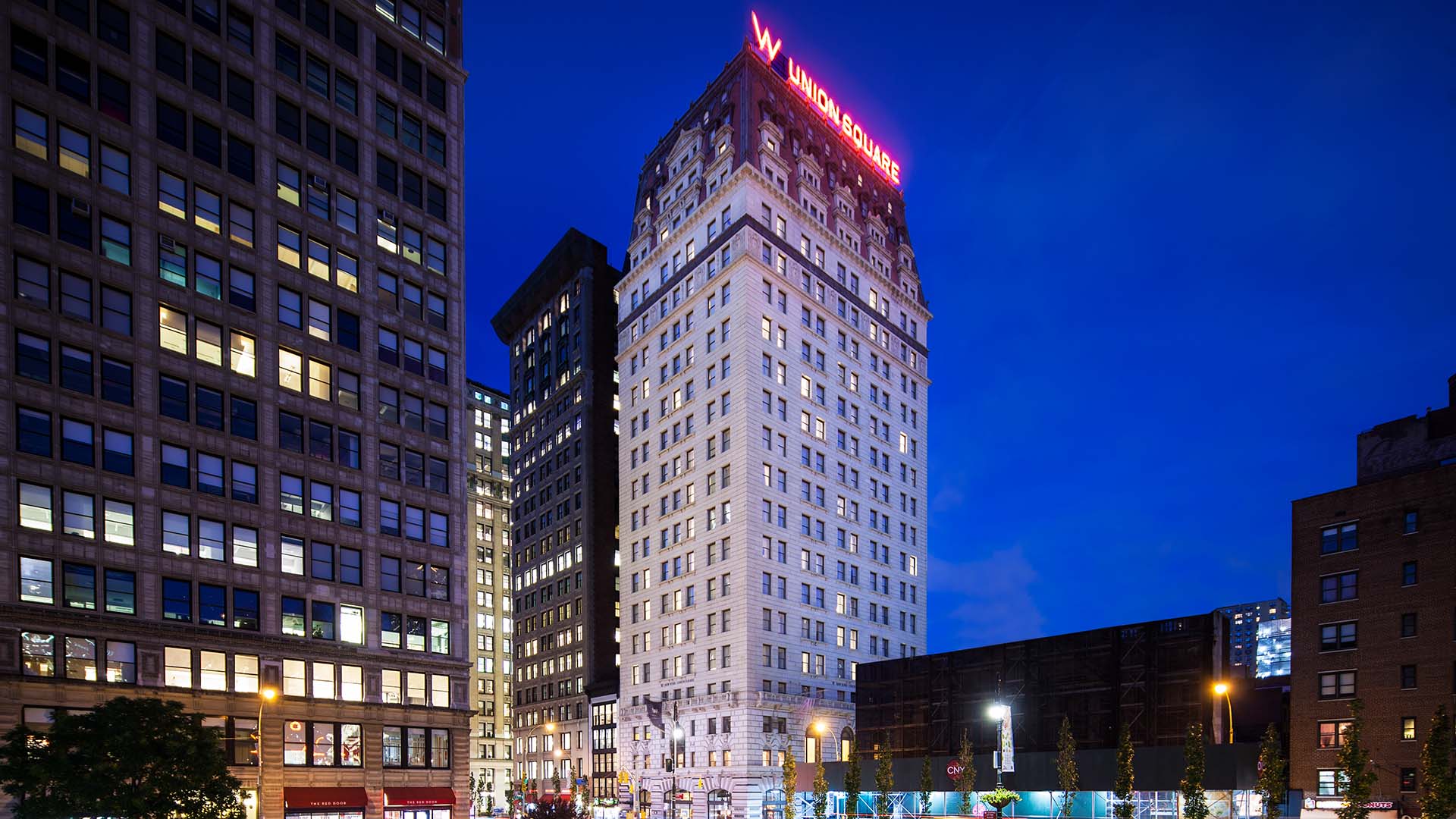What do an airport terminal, the set of a Broadway show, and one of the most revered parks in New York City have in common? They’ve all been shaped by renowned designer David Rockwell — and they all reveal the hidden choices that go into designing a public space.


David’s work shows a deep understanding of gathering places, in-between spaces, and transitions. He can shape a lobby, an atrium, or even a staircase to connect people with their surroundings in unseen ways. And there’s no better place to explore this masterful sculpting of public spaces than New York City, where David first designed W New York – Union Square during the late 1990s.
For nearly 25 years, this hotel towered over Union Square Park, within the historic Beaux-Arts Guardian Life building. Then, David was invited back to completely reinvent the hotel — the first in a series of transformations being made to W hotels across the world.
In this episode, David shares how his love of theater and his knowledge of Union Square’s history helped him to bring “one of the great living rooms of New York” into the hotels’ architecture and interior design, celebrating the many ways that Union Square Park acts as a stage for the city that never sleeps.
- 01:37 — What do an airport and a hotel have in common, and why did David work with a choreographer to design an airport terminal?
- 04:45 — How has Union Square, New York evolved since the year 2000, and how can that evolution be reflected in a hotel’s design?
- 08:00 — Why focus on a single staircase when overhauling a hotel lobby?
Featured Hotel: W New York – Union Square
Featured Designer: David Rockwell, The Rockwell Group
Explore more stories about hotel design at Travel by Design
Follow host Hamish Kilburn’s hotel design reviews @HotelDesigns and global travels @hotel_travel_editor
TRANSCRIPT
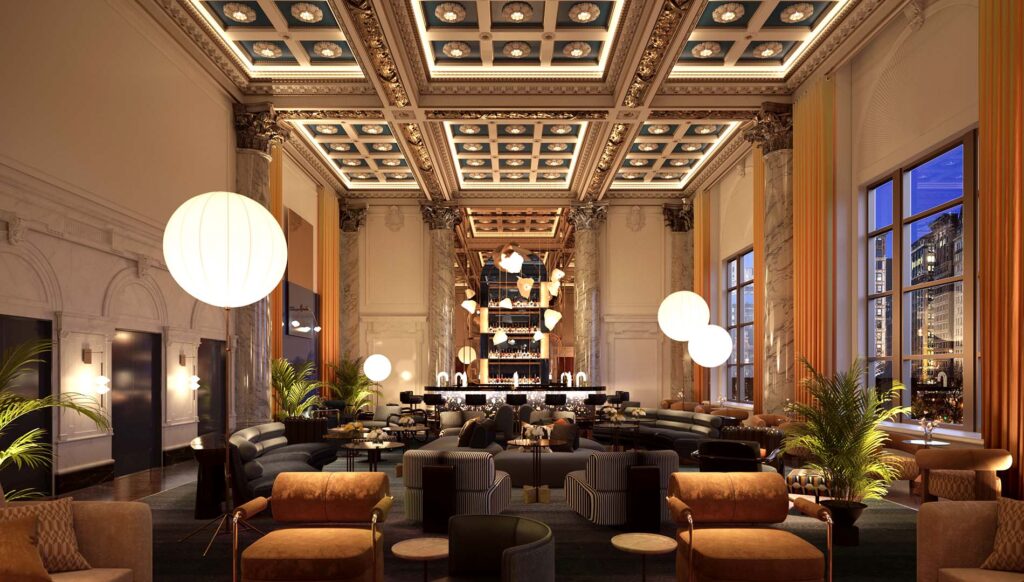
David Rockwell: Originally, Union Square was a place for celebrations, for protests, and I feel like it has become, now …
MUX Begins — “Pokettoni” by Sugoi
… so much more fluid. It is a green market one day. It’s a concert the next day … the diversity, the, you know, amazing tapestry of New York …
The park has taken on the kind of electric energy of the city.
And we’ve embraced that.
Show Open
HAMISH VO: This is Travel by Design — where we chat with the visionaries behind the world’s most extraordinary hotels.
I’m your host, Hamish Kilburn, professional hotel reviewer and the editor of Hotel Designs.
And today, our destination is Union Square Park — in the heart of lower Manhattan, in New York City.
In the late 19th century, Union Square hosted the first Labor Day parade in the United States.
These days, Union Square Park is still a vibrant gathering place — brimming with commuters, merchants, skateboarding teenagers, al fresco coffee meetings, and all the other moments that fit into a New York minute.
For decades, Union Square has also been the professional backyard of renowned designer David Rockwell.
David Rockwell: I’m the founder of the Rockwell Group, and we’re an architecture and design firm based out of New York, Madrid, and Los Angeles.
HAMISH VO: In the late 1990s, David brought his love of theater and deep understanding of public spaces to the design of W New York – Union Square.
More than twenty years later, he’s completely redesigned this hotel — which inhabits a tall, pre-war building off the northeastern corner of the park.
But before we got into that, I asked David about another essential travel location he designed: An entire terminal at John F. Kennedy airport.
I wanted to know: What do an airport terminal and a hotel have in common?
MUX Fades Out
Act 1: What do an airport terminal and a hotel have in common?
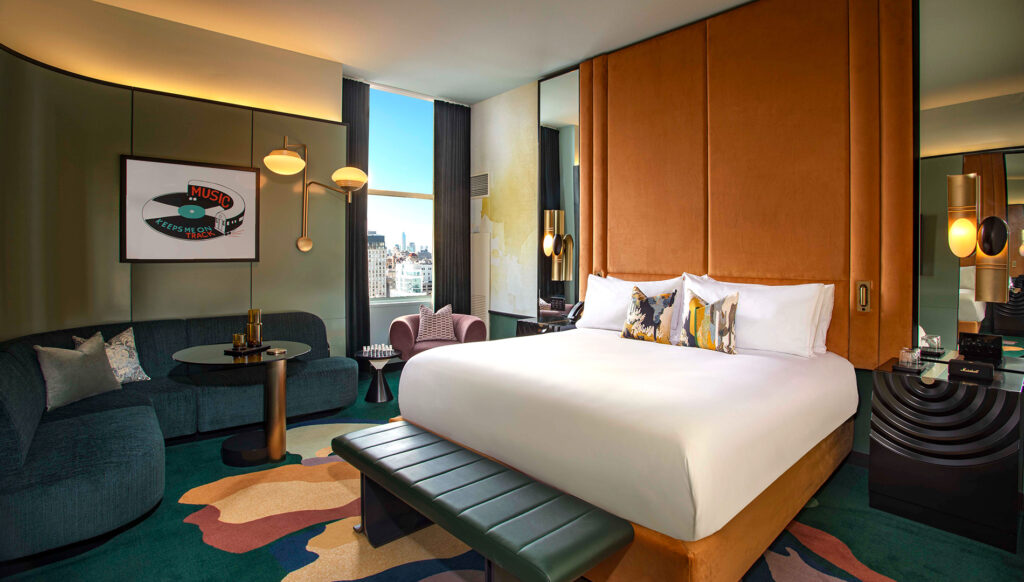
David Rockwell: I think from a design point of view, I’d been a fan of airports and a student of airports for 10 or 15 years, before we had a chance to design the first airport.
And in fact, any time I had an interview about “What was my dream project?” I would talk about how airports seemed to be these kinds of dehumanized experiences, where there’s just a lack of welcome and intuition, locality, celebrating where you are — which of course is very much what you want to do in a hotel.
And another thing that’s similar is, if you were to really X-ray an airport, and say what makes for a great experience, it’s not so much what you see, but it’s how it moves, how you function, how you feel in it.
Hamish Kilburn: I really recognize that, because I, sometimes when I get to a destination, I just feel out of sync — I feel like I need a bit of help to just … get into the rhythm of the place.
David Rockwell: Yeah. And I think that that’s very much true in a, in a hotel room. I think if you look at what most people’s frustrations in a hotel room would be, it has to do with what the architect and designer have done to accommodate feeling welcomed and comfortable.
So graphic design, movement, all of that was tackled as a kind of choreography.
Hamish Kilburn: And, and I heard you actually hired a professional choreographer.
David Rockwell: Yeah.
Hamish Kilburn: It’s just so wonderful in so many ways, because I can, I can just so imagine kind of dancing into New York City, it’s so romantic!
David Rockwell: Well, I first have to tell you, the way I met this choreographer …
Hamish Kilburn: Oh, please.
David Rockwell: … was designing my, my first Broadway show, which was in 1999.
Hamish Kilburn: Wow.
David Rockwell: And we had done many shows together.
So what he provided was a chance to study movement patterns in Central Park, in Grand Central, and think about what the dance of New York would be.
And there are things that, as designers, we all know — like, you tend to move towards a destination.
But there’s all the kinds of tools of theater, like transformation and seduction, where you can have a corner that you don’t quite see until you move around it …
So we brought in a lot of conversation for the client to understand what New Yorkers understand, which is: Movement and chaos is just part of the city, if you can organize it.
Act 2: How does a hotel embody the evolution of a historic public park?
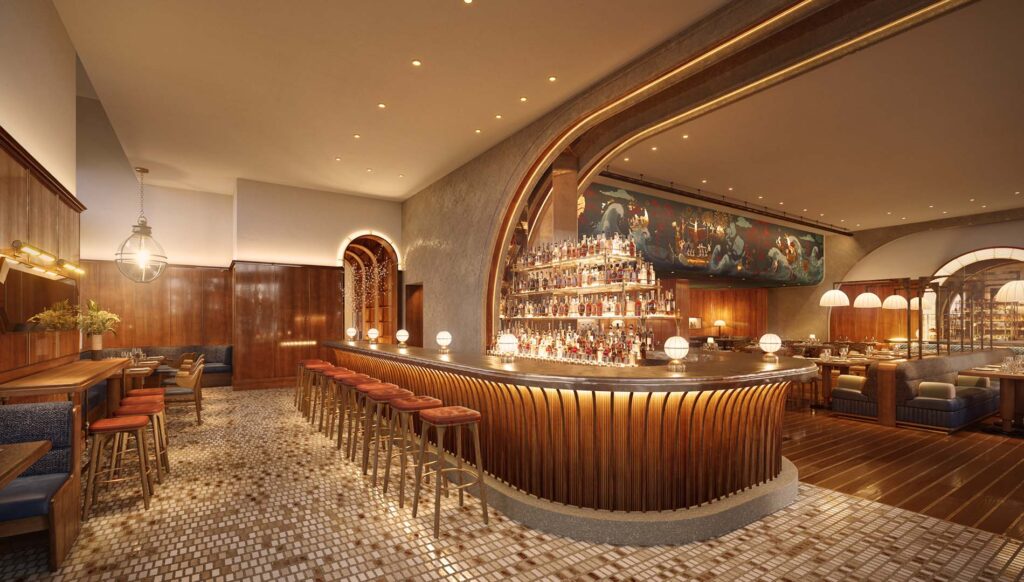
Hamish Kilburn: So moving on, you’ve completed a total reinvention and renovation of W New York Union Square.
And this is the rare thing, and I really want to emphasize this, because you were asked back onto the project that you originally designed.
I have to ask you, what’s the difference between the life of Union Square as you knew it then in 2000, to the life of Union Square that we would see today in 2023?
David Rockwell: Well, first of all, what an amazing, unprecedented privilege …
Hamish Kilburn: Yeah.
David Rockwell: … to be invited back to revisit a project that I so loved. Um, we work on Union Square and have been here for 30 years. And the original design was a total labor of love.
It was in some ways done at a time when I knew Union Square less.
At that time, Union Square was being used for a kind of beautiful green space; it’s the destination at the end of Broadway, so it’s a seminal place geographically in New York.
The building’s a phenomenal landmark building, built in 1911. And fashion was focused in this neighborhood …
But in the period of time from 2000 to now, it has become a place that more replicates what it was historically. Originally, Union Square was a place for celebrations, for protests, and I feel like it has become, now, so much more fluid.
It is a green market one day, it’s a concert the next day, it is constantly full of activity …
And as a park that is relatively symmetrical or axial, what’s happened now is much more free flowing circulation. And I feel like the park has taken on the kind of electric energy of the city.
Hamish Kilburn: Sure.
And I suppose that’s a testament to a great public space, that it can survive over so many periods of time and survive as so many different kinds of spaces.
For instance, it’s a great source of public art. There’s constantly people out there creating art. And that is, you know, an interesting idea to think about, how a hotel lives with that.
It is a place of a wide variety of activities throughout the day, the diversity, the, you know, amazing tapestry of New York, and Union Square is, in some ways, one of New York’s great living rooms.
Hamish Kilburn: And when you think about the hotel and the way it relates to Union Square, and the park, what was that relationship in the past, and what’s the change that you’ve made to the relationship of the location through design?
David Rockwell: Yeah, I think in 2000, we saw it more as a kind of haven. And I think that notion of hotel as retreat, kind of reflecting Union Square as a background, has been flipped a little bit now, and we’re, in some ways, bringing the explosive energy of the park into the hotel, with all of the things that happen in the park that make it a kind of unique spot in New York.
People playing chess, a Greenmarket, performances, spaces that transform through local artists, in many cases through projection, so it can happen on an ongoing basis.
Spaces that have landscaping on a scale that are really architectural and will change based on the season; that happens in the park. It’s one of the great things about Union Square, is you see a change from hour to hour, day to day, and season to season.
Hamish Kilburn: As well as, like, the energy changing or shifting, hospitality trends have changed as well. Like, there’s a new restaurant on the ground floor, which is open to the public and incorporates ingredients from the Union Square Greenmarket.
David Rockwell: Also local artists, local craftsmen, and the restaurant has a very prominent seafood bar right on Union Square.
David Rockwell: So I think it’s going to feel like a total extension of the park.
Hamish Kilburn: Mm.
Act 3: What happens when you make a staircase your scene-stealing lead?
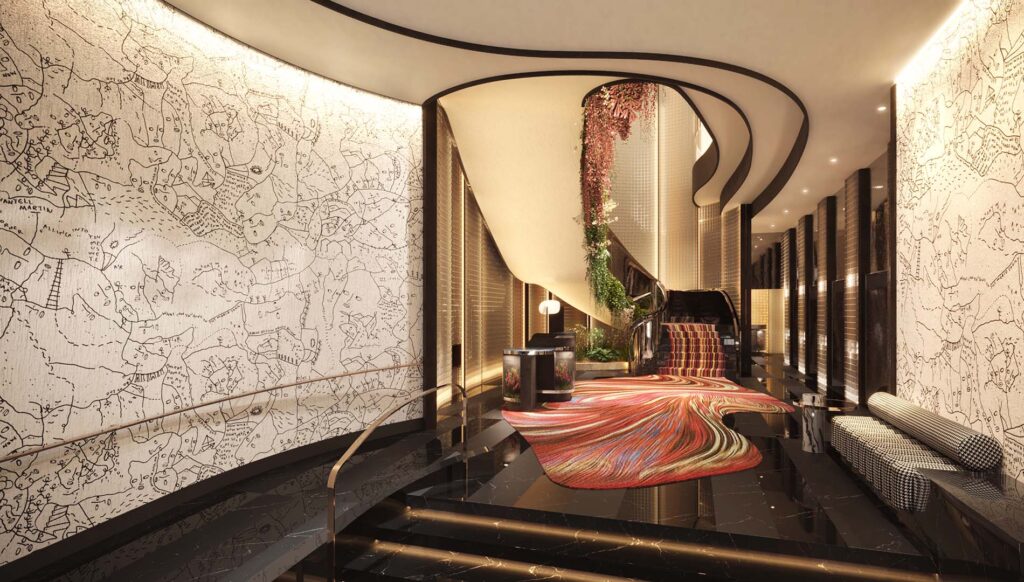
Hamish Kilburn: We talked earlier about how public spaces either channel or influence the pace of people moving through them. And I know that one of the big changes here is, is the hotel lobby. So I want to describe this for the listeners.
Before, you had this large welcome desk, and it was underneath, um, a staircase that takes you up to the second floor. And it was very clearly a hotel lobby, conventional if you like, and there were a lot of right angles, and it was just, you know, it was very clear where the lobby desk was.
But now when you look at the lobby, all I can see when you walk in is that curvaceous staircase, and you have plants that are growing down from the banisters, there’s that colorful carpet that spills from the stairs to the lobby, which really blurs the boundaries between spaces …
It’s less angular. There’s like a lack of right angles, everything’s more fluid, and feels like the shoulders have relaxed in the hotel.
David Rockwell: Well, that’s absolutely true, because, in fact, it’s a much more explosive use of color and form, and when we started the hotel, we knew we wanted that stair to be a central, featured, dynamic element.
It really fills the lobby, because it’s in some ways meant to be a transportation place that seduces you and connects the second floor with the ground floor, so they’re not separate experiences.
Very different from, kind of the bones of the original Union Square W, where the lobby was confined to downstairs.
Hamish Kilburn: Absolutely, and I just want to let you know that you are responsible for changing my whole perception on stairs.
You mentioned in a video once that stairs are an art form, and it’s so true actually; when you were describing, you know, stairs are completely different to every property, and they, they offer a different function, and there’s no reason why we can’t take art from outside a frame, put it into areas like the flooring and the stairs, and it’s an exceptional example of exactly that, this hotel that we’re talking about.
David Rockwell: I also think stairs ascending has a certain emotional quality.
And in this case, what it did is, it does a pirouette to face the front door as the risers get wider.
Hamish Kilburn: Mm.
David Rockwell: So it really is like a kind of river that moves up, with the carpet flowing down, and then the carpet and the banister and the flowers really feel like almost a gravitational spill down to the ground, to pull you up …
Just a whoosh of energy from the park, up that stair, into the lobby.
Hamish Kilburn: Mm.
David Rockwell: Where the living room has now been reset, and then that second floor is now given back to the public.
There’s also a great elevator right next to it, and one of the things, you know, more and more you have to do, is make sure these spaces are accessible to everyone.
Hamish Kilburn: Of course.
David Rockwell: So the elevator experience is actually part of the stair experience as well, so …
Hamish Kilburn: And, you know, these are shared spaces, like the living room, which also locals can utilize, and it’s going to have its own programs.
And I just applaud you for thinking about the in-between spaces; these spaces are areas that used to just kind of be dead corridors or extensions of corridors.
David Rockwell: We do live in these interstitial spaces. That’s what an airport is. That’s what a lobby is.
And I think the rooms are more and more like a mini vacation. And I think linking outside, inside, history, and then a sense of exuberance …
I think it makes things possible. It makes it possible to think of the second floor as an extension of the park, a public space.
Hamish Kilburn: David, it’s been such a true honor speaking to you. You’ve accomplished so much as a designer, as an architect, and just hearing about the spaces that you’ve designed, from terminals to a flight of stairs in a hotel, the amount of thought that goes into these spaces …
It just reminds me that, you know, when this kind of work is done correctly, it’s invisible to everyone and travelers, and it really is subconscious — yet incredibly impactful on how we make our journeys, and hopefully …
MUX Begins — “Overlander” by Steven Gutheinz
how we make genuine connections along the way, not only with these spaces, but with people around them as well, so …
Thank you so, so, so much for your time today. It’s been amazing.
David Rockwell: Totally my pleasure. I really enjoyed the conversation.
Credits
HAMISH VO: Travel by Design is a podcast by Marriott Bonvoy Traveler, the online travel magazine where you’ll find more inspiring hotel design stories.
If you’re curious about the craft of hotel design, then check out marriottbonvoy.com/travelbydesign.
And if you want to go behind the scenes of my travel experiences across the world, then follow me on Instagram @hotel_travel_editor.
HAMISH VO: This episode was produced by Narratively Creative. Our Senior Producer is James Boo. Our Associate Producers are Nidhi Shastri and Greta Stromquist.
Interview recording by Rachel Yang.
Story edits by Priscilla Alabi, sound design by James Boo — and audio engineering by Dorian Love.
HAMISH VO: Our Marriott Bonvoy Traveler producers are Valerie Conners and Robin Bennefield.
Special thanks to David Rockwell for speaking with me about his work.
I’m your host, Hamish Kilburn. Don’t forget to subscribe to Travel by Design in your podcast app. And tune in next time to hear more design stories behind the world’s most extraordinary hotels.
MUX Ends
